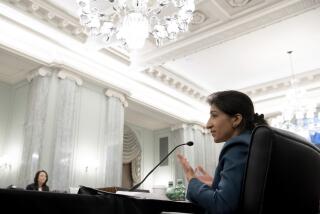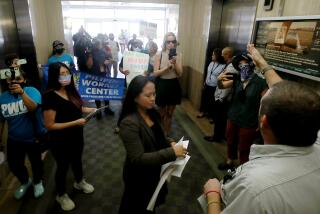Worker Abuse Is Documented; Now, Action : Labor, gasping from unfair employer tactics, needs laws, not sympathy, from government.
The first installment of a study by the Clinton Administration’s Commission on the Future of Worker-Management Relations was released with great fanfare in Washington earlier this month. The 10-member panel, headed by former Labor Secretary John Dunlop, spent more than a year pondering what forms of employee participation, collective bargaining and dispute resolution might boost American productivity and competitiveness and, not incidentally, improve working conditions.
But the commission’s findings provide small comfort to the workers who testified before the panel about how management related to them when they tried to improve their standard of living or job security by forming a union. Even after the commission heard many wrenching tales about violations of workers’ rights in organizing campaigns, its report emphasizes upbeat accounts of “employee involvement” at non-union firms rather than discussing what needs to be done to curb unfair labor practices by employers.
At Dunlop Commission hearings around the country, employees reported that attempts to unionize are routinely crushed with harassment, threats, intimidation, anti-union propaganda, legal delays and blatant discrimination against union activists. Little help is available from the National Labor Relations Board, the federal agency responsible for enforcing workers’ right to organize and bargain.
Witnesses told the commission--whose members are mainly academics--about careers damaged, jobs lost and lives disrupted due to widespread union-busting. When workers are lucky enough to win a union representation election run by the NLRB--and few do--management law-breaking doesn’t end there. Statistics compiled by the commission show that “roughly 40% of workplaces that vote to be represented by a union do not obtain a contract with their employer” because so many companies “engage in bad-faith bargaining with newly certified unions.”
In a typical bit of understatement, Dunlop & Co. agree that “the probability that a worker will be discharged for exercising legal rights under the National Labor Relations Act has increased over time.” In addition, the commission’s interim report hints at the existence of another trend that is depriving millions of workers the chance to exercise those rights.
Many companies are now arguing successfully that their personnel aren’t even “employees” entitled to protection under the law, but managers, supervisors, independent contractors, part-timers or temps. The crowning blow came May 23, when the Supreme Court ruled that a group of licensed practical nurses--long near the bottom of most health-care hierarchies--were part of management. It effectively barred them from organizing a union on the grounds that they “coordinated” patient care by other workers.
This cockeyed interpretation and the failure of labor law generally cry out for congressional relief. But, instead of immediate action on remedial legislation, the Dunlop Commission proposes another six months of “discourse” to achieve a labor-management consensus on how to reduce conflict and increase workplace cooperation. By the time the White House receives any final recommendations, it will be after midterm elections, which are not likely to improve the congressional climate for labor-law reform. Dunlop’s search for consensus is, furthermore, a fool’s mission. Contrary to one of his “principal findings,” management does not share with “labor and the general public” any real support for “the principle that workers have the right to join a union and to engage in collective bargaining if a majority of workers so desire.” The behavior of virtually all non-union bosses, when faced with employee organizing, proves how little support there is.
Few members of the commission or the Clinton Administration resemble the architects of labor-law reform 60 years ago, who produced the now-tattered NLRA. In that era, labor-oriented academics and Democrats championed collective bargaining as a cornerstone of industrial democracy and economic justice. Today’s crowd of labor-policy advisers value unions only if they increase productivity and efficiency--a task most managers would rather assign to employee committees, teams and quality circles under company control.
Restoring the right to unionize will take sustained grass-roots pressure and publicity. Worker protests over worsening job conditions will provide the main impetus for reform, just as they did during the New Deal. Community/labor coalitions, like the national “Jobs With Justice” network, can recruit students, churches, civil rights and women’s groups as allies in the fight. Waiting for deliverance from Dunlop, however, is like waiting for Godot--it’s never going to arrive.
More to Read
Inside the business of entertainment
The Wide Shot brings you news, analysis and insights on everything from streaming wars to production — and what it all means for the future.
You may occasionally receive promotional content from the Los Angeles Times.










